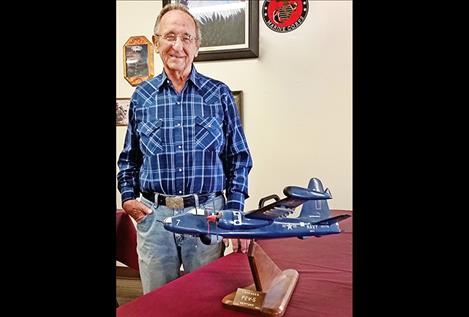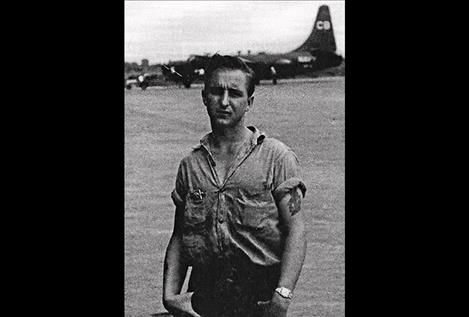Veteran Spotlight
Richard L. Tobel October 10, 1931 Korean War: Naval Structural Mechanic – 2nd Class U.S. Navy
Hey savvy news reader! Thanks for choosing local.
You are now reading
1 of 3 free articles.
Richard was a young man in Jordan, Montana, when he enlisted in the Navy. He was about to be drafted – at least he thought he was about to be drafted. He and a friend went to Butte where he remembers a Navy doctor in uniform. They both passed tests “to be eligible to be accepted.” It was March 1950, just before the Korean War started.
In his twelve weeks in boot camp in San Diego, at the Naval Training Center, Richard took general classification tests. He was an innocent young guy off the prairies of Eastern Montana and didn’t know how serious these tests were. If your test grades were not good, the Navy assigned you somewhere.
Richard’s grades were good so he could select his area of service. He was always a nut for planes and built models as a kid, so he chose naval aviation. He had a ten-day leave after boot camp, but it took three days each way home by bus so he only got to spend three or four days with his parents. He returned to San Diego and subsequently went by train to the Naval Air Technical Training Center in Memphis, Tennessee. His six months there trained him to be an aviation structural mechanic. He learned about everything that kept planes from falling apart.
After Memphis, Richard went all the way to the other coast to Ault Field at Whidbey Island N.A.S. (Naval Air Station), Washington. This trip took him within 86 miles of home on the day before Christmas, but there was no chance to stop off. He was assigned to Patrol Squadron 1 (VP-1) working with the nine-man crew for the P2V-5 aircraft, also called the Neptune. Richard’s squadron was the first to get this brand new plane.
In April 1951 Richard was assigned his first 6-month tour to the Korean combat zone at Naha Naval Base, Okinawa, a Japanese island. Quarters were tents and Quonset huts. The planes he worked on spent six to ten hours at a time on anti-submarine patrol, protecting the US 7th Fleet from Russian submarines. The planes also flew low-level photo missions looking for Russian spy ships. Their orders were to never fire unless fired upon first. Luckily, they were never fired upon.
After six months, Richard returned to Whidbey Island for six months at his home base. His next 6-month tour was to Atsugi Naval Air Station, Japan, after which he was back for six more months at Whidbey Island.
The third and final tour was to Kadena Air Base in Okinawa in 1953. His squadron took ribbing from other squadrons because they were rated high flight readiness status and were known as the “fleet’s finest patrol squadron.”
The U.S. was very interested in the MIGs the Russians flew. A North Korean defector flew his MIG and landed in South Korea. The US Air Force dismantled the plane and had it sent to the station where Richard was based. After putting it back together, Chuck Yeager, a famous test pilot, was brought in to fly it. Richard remembers watching the test flights every day but their area was too far away to see much.
On one of his ocean trips, the plane developed mechanical trouble and landed on Johnston Island. Repairs were made, but what Richard remembers is that the island was so small each end of the runway was in water.
When the truce was signed that ultimately ended the war, Richard made his final trip back to the States, leaving before his four-year enlistment was up. He was asked to stay in but said, “No, thank you!” He was sent to a receiving station in Seattle and mustered out in December 1953. His beginning monthly salary had been about $85/month and his muster-out pay was about $155. On the train back to Miles City and finally Jordan, he had mixed emotions. Of course he was glad to be going back home, but … everything was different from when he left four short years before.
The Korean War was called a “police action” because war was never declared, but it was a war to those who were there. Richard’s heroes are the Army infantry and the Marines who paid such a high price in WWII and the Korean War. The support of the Navy and Air Force were essential, but it was those on the ground who suffered greatly. Richard doesn’t speak of individual actions but takes pride in the accomplishments of his squadron. Today he still keeps track of a friend in Kingston, Tennessee named Bob, nicknamed “Shotgun.”
Richard doesn’t know about having a draft today. Especially in these uncertain times, a strong military is necessary, but volunteers are better. There may be a time when a draft is needed. Would he do it all again? If his country asked, he would be there gladly and in a heartbeat. He advises young people to join because the military is a great thing for any young person. “If you do go, take boot camp seriously!” he said.
Recently a P2V-5 plane has been installed at the entrance to Bell-Johnson Field at the Missoula airport. The Missoulian article telling all about it joins the many photos and articles Richard keeps in a military file folder.
Richard earned the United Nations Service medal, the Korean Service medal with two bronze stars representing his first tour plus two more tours in the Korean War zone, The American Defense Ribbon, the Japanese Occupation medal, and his Good Conduct medal.
Thank you for your service, Richard.

















